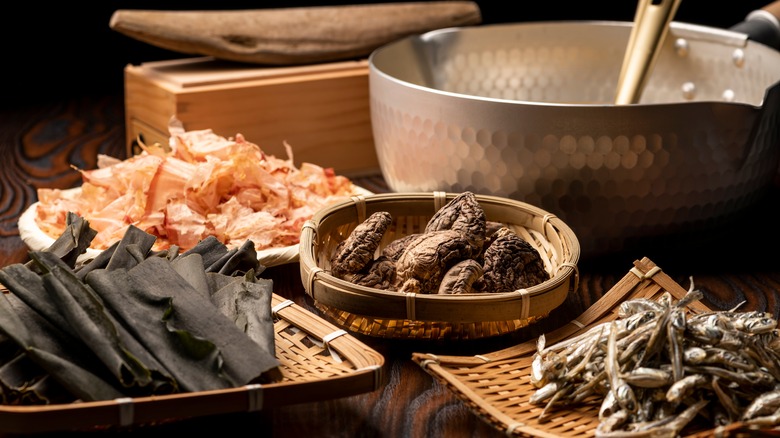The Semi-Modern History Of The Word 'Umami'
There are a million ways to describe the flavors of a specific dish. But with a diverse offering of food from every corner of the world, there are still never enough words in any language to describe how some of those truly next-level meals taste. From tangy bites of orange-glazed salmon, still crackling from the oil in the pan, to hearty slices of pizza with a rich smattering of soft cheese, the list of deliciousness goes on for miles.
Despite the different smells and tastes that each dish offers, at its core, there are only five basic components of taste to describe it all. According to Le Cordon Bleu, those few elements are saltiness, sweetness, bitterness, sourness, and umami. While most of these components of flavor feel fairly mundane to the world now, one sticks out as truly unique, the elusive umami. But what does umami really mean? And where does the term come from?
So what exactly is umami?
Per MasterClass, the actual definition of umami literally means "pleasant savory taste" in Japanese. Digging a little deeper, per Real Simple, umami itself is a flavor also characterized by heartiness, and is primarily found in an ingredient known as MSG. The taste is found a lot in foods found in Japanese culture like umami-forward miso, seaweed, mushrooms, tomato sauce, fish sauce, and some meats to name just a few, via Masterclass. As food critic Hannah Goldfield defines umami, it's the "deep, dark, meaty intensity that distinguishes seared beef, soy sauce, ripe tomato, Parmesan cheese, anchovies, and mushrooms, among other things", via The New Yorker.
According to Reader's Digest, it's difficult to pin down a truly specific description of umami's taste, but other food scientists have described it as "broth-like" in nature. Another popular characteristic of umami is that it lingers on your taste buds longer than the other four flavors.
While umami is a recent addition to the palate of many people in Western cultures (with translations not making it to the U.S. until 2002, per Reader's Digest), it's been recognized in places like Japan for over 100 years.
The origins of the fifth flavor profile
The origin of the umami flavor is relatively new having only been discovered just over 100 years ago. Per Real Simple, the discovery of the word is all thanks to a Japanese chemist by the name of Kikunae Ikeda. According to Gary Beauchamp, President of the Montell Center (a center for the study of taste and smell), Ikeda discovered the taste in 1908, via Vox. He apparently became aware of the flavor after recognizing a taste that was unique enough that it could not be easily defined by the other four elements of flavor.
Per Ajinomoto, Ikeda was sipping on a bowl of his wife's kelp broth when he made the discovery. After the realization, Ideka became intrigued by the taste so much that he spent much of his career dissecting the umami flavor down to its most basic building blocks.
Looking at the science, the unique flavors of umami are primarily thanks to something called glutamate, an amino acid also known as monosodium glutamate or MSG. According to MasterClass, this additive is also very common in Chinese dishes. So the next time you indulge in a savory meal, see if you can pick out those notes of umami, and be glad we finally have a concrete word to describe those distinct flavors.


